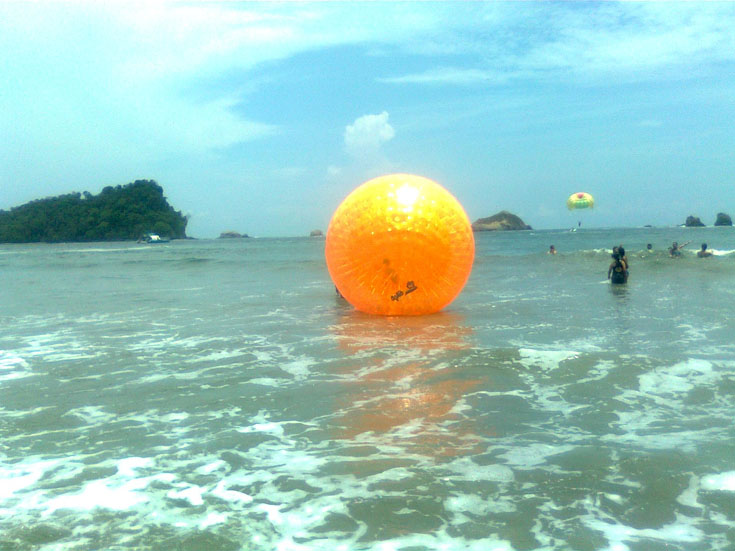|
|---|
When It First Appeared at Manuel Antonio Beach I Thought It Was the Setting Sun But Quickly Realized It Was a Large Plastic Ball With a Core That Can House People! If You Look Very Carefully You Can See the Outline
of Two Children Sitting and Standing in the Center Bubble That's Within the Bubble |
Broken News
The Chronicles have regularly reported on of the angst between Costa Rica and Nicaragua concerning the piece of Ticoland in the northeast corner of the country that the Nicas expropriated in October of 2010 (see INVASION). There was no reason or justification given at the time (just unsupported claims of ownership) as to why the Nica government bothered to slice off a relatively remote and poor piece of real estate.
Speculation focused around two possibilities: (1) Nicaragua wanted to cut a shorter route and new mouth for the San Juan river that separates the two countries for over a hundred miles and (2) to prepare for the possibility of realizing an old dream; the building of a canal from the Caribbean to the Pacific in direct competition with the Panama Canal.
Now comes word that Señor Presidente Ortega in June submitted a law to his government that "advances" the construction of just such a canal.
Now there happens to be two 19th century treaties between Nicaragua and Costa Rica that supposedly give Costa Rica a say on such a canal. Yeah baby, fat chance. Danny has already ignored the complaint the Ticos registered with the International Court of Justice in the Hague about the land expropriation and there's no reason to believe he wouldn't do the same when digging his ditch.
The implications of this scheme go far beyond two small countries in Central America arguing with each other. Nicaragua is a poor country and would never be able to fund such a construction, estimated to cost as much as $30 Billion. They don't have any appreciable quantity of oil (they get theirs from uncle Hugo Chavez) nor other natural resources that they can use to offset the cost... but wait a minute, there just might be a way.
Enter Danny Ortega's friends, some of the most troubling and trouble-making characters in the world (see Danny and His Friends). Sweet guys like Hugo Chavez, Iran's Ahmadinejadand the Señores Castro in Cuba. Now the only thing that cast of characters has in common is a super hate for the U.S. and a desire to cause grief among the gringos whenever possible. A second canal would not only provide income to the "investors" because of somewhat faster ship times for East-West bound freighters than the current canal but it would also irritate the hell out of the U.S. Sounds like something too attractive for them to pass up.
The Chronicles will keep its ace reporters (you know who that is) on the story as more is revealed.
Quepos Quivering Again
In mid-June Quepos was hit with another tremor that was reported to be in the 4.7 Richter Scale range. Now that's fairly strong but this level is not usually enough to do even minor damage. What made it feel stronger was that it was epicentered only 20 miles off the coast from our hero's kitchen stove and was a relatively shallow tremor.
 |
|---|
Earthquake Map (only 4.0 or Greater) for Costa Rica from 1973 to May 2012 |
The Chronicles reported back in June of 2010 (see SHAKIN) on a similar but more powerful episode (6.2 R) when my apartment building shook for some 15 to 20 seconds. That makes the 2010 episode about 150% of the energy expended as compared to this current shaker.
This time the shaking, which happened around 6:45 in the morning, only lasted 5 to 10 seconds. My Spanish teacher and I were at the computer; he was helping me correct my translation of the latest news from La Nación, our biggest newspaper. Although he was born here and spent most of his life here, tremors are unsettling to veterans and neophytes alike. When the tremor hit, Jorge got up, crossed himself and headed for the front door mumbling something indecipherable in Spanish.
Yes, we live in a seismologically sensitive area. Check out that map to the left. Each dot represents a tremor from 1973 to 2012 that was 4.0 or over and the red dots are those that registered from 7.0 to 7.9. The 2010 Haiti tremor was 7.0, the greatest in the Caribbean in 120 years. Notice on the map that there are four red dots and two of them are in the Gulf of Nicoya in the north. Also notice that above the Nicoya, as one proceeds into Nicaragua, there is a heavy cluster of 4+ and 5+ tremors as well as one 7+.
The Seismological Center at the University of Costa Rica stated that there was an average of six tremors a day in May of this year and a total of 185 for the month (if that average held since 1973, there have been a total of over 85,000 tremors since then, although most were recorded on seismographs but not actually felt by humans). The agency also stated that "All three of Costa Rica's earthquake monitoring agencies have noted that the area around Quepos is a location of frequent quakes".
Thanks guys for noticing, any ideas on what we can do to stop them besides getting up, going to the door and praying?
Costa Rica in Futsal World Cup
I've written before (see Futbol! Futbol! Futbol!) on how much I enjoy walking the two blocks up my street to the Sala de Futbol (or futsal) in Barrio Los Angeles and watching the guys kick the pelota around. I manage to do this two or three times per week for a half hour to an hour and I suspect that I'm now viewed as that crazy old gringo dude Bob who cheers on both teams in every game. (Some of the locals are now yelling "Bob!" when I come in; they don't know I have already been nicknamed Bob Esponga or Sponge Bob at Super Mas)
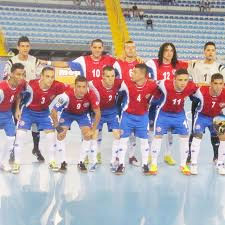 |
|---|
Costa Rican National Futsal Team |
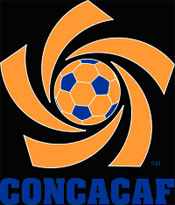 |
|---|
 |
Indoor soccer is played all over Costa Rica and in virtually every other country in the world. Just like outdoor soccer, futsal also has regional competition leading to a World Cup.
So it was interesting to me that the Costa Rican national futsal team recently beat Guatemala in Guatemala City to secure it's place among the CONCACAF (Confederation of North, Central American and Caribbean Association Football) teams competing in the World Cup finals in November to be played in Thailand.
The final four from CONCACAF, in addition to Cost Rica, includes Guatemala, Mexico and Panama. The United States, Canada and 30 caribbean countries did not qualify this time.
Vamos Ticos! Solo Bueno!
Pedestrian Pedantics
(Observations on Walking and Driving in Costa Rica)
It seems everywhere our hero has lived there has been some peculiar characteristics associated with local driving and local drivers. Costa Rica is no exception.
 |
|---|
¡Pura Vida! |
My mother, God rest her soul, used to say that Massachusetts. where I grew up, is a land of driving "cowboys". I must admit, now that I have lived in several states and countries, that Mass is the only place where I have ever been passed on the right side on a soft shoulder at 70 miles per hour (eee-hah!).
In Pennsylvania (GG lived there at two different times for a total of 19 years), it seemed that many drivers stretched the traffic lights to take advantage of the two second delay between when it turned red in one direction and green in the other. The problems started when one car kept going after the light in its direction turned red and the opposing and impatient dude in the other direction jumped the intersection in anticipation of the green. Crash, bang, zowee, oooomph! (darn, I miss TV's Batman).
In Europe, Brussels has recently been appointed the worst city in all of Europe for traffic jams. Personally, I nominated it for that honor much earlier when I lived there in the mid-seventies for 2 1/2 years.
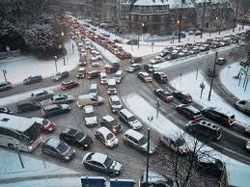 |
|---|
Downtown Traffic Jam in Brussels |
The Belgians are not known for their driving manners and should one vehicle edge out another in traffic the offending driver will almost certainly receive a contortionary arm movement that includes a pivoting finger pointed to the head to indicate the offending driver is crazy. Unfortunately, I was never able to pick-up the French or Flemish slurs that accompanied the hand gestures. Sacre bleu!
In Florida (10 years) it behooves one to practice patience when a 90 year old great-grandmother with blue hair, who's driving an old wide-bodied '79 Continental (in mint condition I might add), is hanging out in the passing lane at 15 miles per hour below the speed limit. Of course her left directional will be blinking as she has definite plans to make a turn-off somewhere in the next four miles.
GG doesn't drive much anymore having foregone that privilege when I moved here four years ago after continuously owning and operating a vehicle for 50 years. Don't miss it a bit. But I have driven occasionally and I do watch Tico drivers from a pedestrian point of view and I can share the following observations:
-
Using the horn. Ticos don't often use the horn in a highly irritating way such as laying on it for 15 seconds (San José may be an exception). But they do use it creatively.and often impatiently. The one practice I find the most interesting is the quarter of a second beep - just a quick tap on the old trumpet. This is used in a variety of ways. It's designed to warn a pedestrian crossing the street that a ton and a half vehicle is proceeding toward them and is within a kilometer from hitting them. It can also be used in this way to warn someone who may even be thinking of crossing the street. The short beep can also be used by a licensed or "private" taxi to attract your attention as they hope to pick up a stray fare. Finally, this kind of beep may also be used by the driver post facto to the targeting exercise described below to let the pedestrian know he was in the cross-hairs all along.
-
Crossing the Street. There are no traffic lights in Quepos let alone foot-crossing lights. You simply look for a judicious moment to make your move and hope for the best. In a small town, of course, that's no big deal. There are foot crossing lights in San José, at least on the main streets . These are particularly interesting as they are divided into two time periods: (1) the period in which you can walk at a normal pace and (2) the period where the beeps accelerate, so it's best to run like hell because the light is about to change (see video right). For many Ticos, the Pennsylvania rules for stretching and jumping lights hold here also.When the Beeping Accelerates, Run Like Hell, the Taxis are Revving Up Their Engines and Looking for Targets (30 sec)
-
Targeting the Pedestrian. This is a favorite pastime for Tico drivers. The objective is to see how close you can come to hitting a pedestrian with your car or motorcycle without, of course, actually doing so. This game is also played in various cities of the world like, for example, in Washington, D.C. where drivers are greatly aided in their targeting by those bright white zebra stripes prevalent at foot crossings. In Brussels it's best to take three armed guards with flares and AK-47's before you attempt to cross any street. In Florida you simply drive your car to the other side of the street.
Advanced Tico targeting practices also require that once a driver has spotted the pedestrian anywhere
from 50 yards to a quarter of a mile ahead, he is obligated to accelerate the vehicle with gusto to add
drama to the near miss. Employing the short beep at the same time gets extra points.
- Handling an Accident. The driving fatality rate in Costa Rica is somewhat higher than the U.S. but still below the world average. If you come across a fender bender you may wonder why traffic is often blocked. This is because many of our roads and streets are two lanes and the rules state that the vehicle must not be moved, even to the side of the road, before the Policía de Transito (2222-9330) and the National Insurance Company INS (800 800 8000) have been called, have arrived and made their own assessment and have put together an accident report, traffic jam be damned.
Let us repeat: Don't move the friggin vehicle. Doing so will trigger a whole new level of bureaucratic
problems that you will end up paying for either at the scene via "suggested" assessments or at the
court house.
GG refrained from renting a car on his first two visits to Costa Rica thinking driving here would be difficult. It isn't - it's really a breeze compared to Brussels. I must admit that when I finally got around to renting a car I did feel safer than walking the narrow Manuel Antonio road with it's side ditches and other walking hazards. That's before I learned how easy the bus system is to use (see Busing Around).
Be aware that there is a new driving test that includes some 45 questions (relax - if you have a valid U.S. license you can get a license here without taking the test). But just in case you need to study for your driving test for some reason, a local electronic newspaper recently suggested some questions in multiple choice format that you may want to know the answer to:
| Study Questions for Costa Rica Drivers Examination |
|---|
1. You are fourth in line behind three vehicles stopped for a red light. How long should you wait before blowing your horn when the light turns green? 2. You are traveling on a busy city street during rush hour. A vehicle nearby brushes your bumper but does not do any damage. What do you do: 4. You are driving in a heavy rain on a typical two-lane country road that has no center lines. What is the safest procedure? 6. You have been out with the boys watching a very important soccer game between West Wonga and St. Mary's School for Young Ladies. You have had six shots of guaro (local sugar cane liquor - Ed.) and five Imperials (the national beer). You have to go home. What do you do. |
Honk if you love Ticos!
Gorditos
(The Obesity Problem: U.S. and Costa Rica)
A recent article in a local paper caught my eye. The Costa Rican Constitutional Court ruled that the ban on selling junk foods in Tico schools is constitutional.
In January of this year, federal regulations here related to elementary and secondary schools limited the serving of food products with high concentrations of sugar, oil or salt such as chips, cookies, candy and carbonated sodas. (Are you paying attention Michelle O?) Now, GG had made the silent observation that there are at least as many obese people here as in the States, despite the fact that the average age here is considerably less than in the states (see Stats on Two States). The article made the following statement:
"According to recent studies, 60% of the Costa Rican population is obese, an alarming fact revealed by the School of Medicine at the University of Costa Rica during the XII Congress of Health and Nutrition in the country." Wow, 60%, amigos!
 |
|---|
Stop It! This is Not Our Hero as You Were Thinking, Just an Example of a "Super Obese" Dude (BMI = 47 kg/m2) |
Internet sources put the U.S. rate at around 36%. This is not one statistic that Ticoland wants to lead the U.S. on, I'm sure. This triggered my interest in the following questions
1) what is the definition of "obese" and
2) how bad is GG personally?
I knew there was some kind of official definition of obesity but I didn't know what it was. Google, of course, provided the answer.
The international formula definition for obesity is based on a term called BMI or Body Mass Index which is a function of weight and height. BMI is expressed as follows:
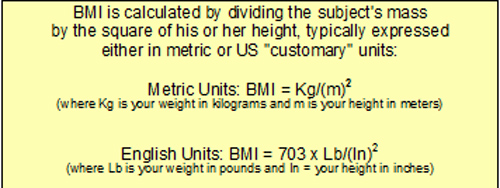
The U.S. Units version results in the same number, of course, because of the "703" conversion factor. I'm not sure how they came to use a term like square meters in their formula; wouldn't it be simpler and more direct to use a linear measurement like kg/meter of lbs/in? The square of any linear term normally is used to measure area like square inches, square feet or square meters. (OK, GG back off, you're quibbling like the frizzled old engineer that you are)
 |
|---|
Former GSA Manager and Chairman of International BMI Convention Held
in Cartagena - "Drinks in My Room After the Session!" |
Now, some international committee (U.N.?) vacationing, err... having a working conference in Cartagena before the U.S. secret service arrived, not only came up with the definition of obesity given above but suggested that a result of 25 kg/m2 was the threshold for being overweight and 30 kg/m2 was the threshold for being obese. I'm not sure how they arrived at these subjective limits but perhaps it was because most of the delegates to the conference came in below 25 kg/m2 (like the dude at the right who definitely has a future with the General Services Administration). I can't help but wonder if these people also worked out the definition of global warming from their lodge in the Alps.
A six foot (1.83 m) dude weighing 255 lbs (115.9 kgs) would have a BMI of [115.9/(1.83x1.83) =] 34.5. That dude would be me. So I must confess that my own BMI puts me over the obesity threshold. Now, I didn't put that picture up of the "super obese" guy above so as to show a decided difference between the "super" obese types and us normal obese dudes in order to put me in a better light - the hell I didn't!
More about the Costa Rica problem. The country has developed the highest standard of living in Central America and has steadily become more affluent, so Ticos can afford to buy more. It seems to me that this is the same thing that happened in the States over the last 70 years. And much of what the modern Tico chooses to eat is high in carbohydrates and fats.
All you have to do is watch Ticos in their daily activities to see why the problem is severe here. Their diet has slipped from the rice and beans farmer plate after a hard day's physical labor to more and more fats and carbohydrates after a day of drudgery at the office. In addition, it is very common to see adults and young children alike placated by endless bags of potato chips, dried plantains, processed snacks and sugary sodas. They start them early and they form bad habits quickly.
Although I feel that any government imposing eating bans in the schools is a definite diminution of personal freedom and individual responsibility, I can understand the motive behind the regulations. The right answer in the long run, however, is education and personal responsibility no matter what country is involved.
Did you calculate your BMI yet? (Bet you did)
¡Pura Vida!
Busy Zompopas
(How to Maintain a Low BMI)
I often stop at a hotel in Manuel Antonio that is nestled in the jungle. On a number of occasions I've noticed a long string of ants running from one spot in the jungle, across and up a stretch of perhaps 20 meters of sidewalk and off into another part of the forest.
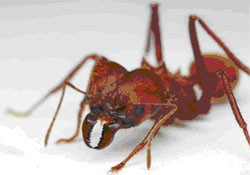 |
|---|
| Soldier - Check Out Those Mandibles |
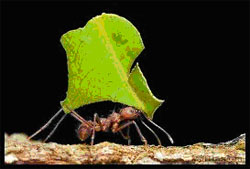 |
A Leafcutter With a Large Cutting |
Leafcutter Dudes Doing Their Thing (37 secs) |
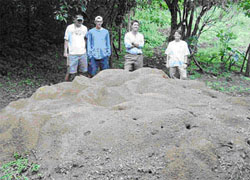 |
Leafcutter Nest |
These are the zompopas (zawm-po-pahs) or leafcutter ants, also known as parasol ants because they carry crescent-shaped leaf cuttings as large or larger than themselves over their heads.
Now I'm not totally unfamiliar with leafcutter ants, having occasionally seen similar ants in Florida and even in Pennsylvania, but the ants here, like many other things in the jungle, seem larger and stronger and more prolific. And being almost totally ignorant of what these little guys do with the leaf cuttings, I presumed they built nests with them like birds do with twigs. So I decided to do a little research.
There's more to it than meets the eye, oh gilded one. In fact they do bring the leaf segments back to a nest, one that can be 250 meters or more from their favorite cutting patch. But they use the cuttings not to pad the nest but to supply an underground fungus garden, from which the colony feeds. I guess that eating fungus every day is an acquired taste, like gallo pinto, but sometimes a small amount of seeds, pieces of fruit and cereals add variety to the menu.
The nests can be a half acre large and are located by the ants in high moisture areas of the rainforest, They can reach as much as 16 meters (50 feet) underground and have thousands of chambers. As much as 80,000 kg (175,000 lbs or almost 90 tons) of earth may have been excavated to build the nest.
There are several sizes of zompopas.in one nest, ranging from 13-27 millimeters (about 1/2 to 1 inch) in length and weigh from 300 to 800 milligrams, That's an average BMI of less than 2 (check my arithmetic please). No wonder these dudes are so strong, they're really fit.
There may be as many as five million ants in one nest that may be four or five different sizes and have different duties. The smaller ants tend to the fungus garden, making sure the leaves are positioned properly and hauling away any accumulated refuse that could develop into a disease. Many of the other ants are there to keep the queen happy.
Ant Humor |
|---|
| Q. What do you call an ant who skips school? A. A truant! Q. What do you get if you cross some ants with some tics? A. All sorts of antics! Q. What do you call an ant in space? A. A Cosmonant or Astronant! Q. What medicine would you give an ill ant? A. Antibiotics! |
Like most ants, zompopas have a queen at the center of the community that makes it all happen. She is serviced by hundreds of workers and slaves (it's good to be queen). The queen, of course, has wings and is able to fly off and start new nests. She does so at night (sneaky wench) and usually only in April or May.
The queen mates with three to eight males (it's good to be queen), stores up to 250 million sperm and can remain fertile for over two decades. When she decides to form a new nest, she flies off as far as 10 kilometers and burrows into the ground to lay her eggs. Starting from a relative few hatchlings, the new nest may reach the 5,000,000 population level after two to three years.
Zampopas are threatened by, and food for, small birds, insects, frogs, anteaters, ant bears (another form of anteater), and humans. They can cause widespread damage to crops and are, therefore, not the best friend of farmers. On the other hand, biologists tell us zampopas aid the environment because their leaves, fungi and waste products help fertilize the soil. Dude, what living thing doesn't have its good and bad points?
And besides, they're kool to watch.
What's-in-a-Word
Gordito (gordeetoe)
The word for fat in Spanish is gordo. Gordito is a diminutive of Gordo and means, essentially, little fat one. Diminutives in Spanish are often used to soften the meaning of a negative word or make a positive word more friendly and intimate (for example, chiquita in place of chica, for little girl).
So, you expected something more profound amigo? OK, hold the suggestions that our hero be re-named Golden Gringo Gordo or GGG.
Mae (my)
Dude, what's happening?
Ticos might say it this way: "mae, que pasa?. Mae is used (prolifically in Quepos I might ad) in the same way gringos, particularly teenagers use dude. And if you listen to a tico teenage conversation you might here "mae" ten times in the space of 30 seconds (make that 15). It's almost as frustrating as listening to a gringo use "you know" 29 times in a short period of time. I retain my composure when I start to hear the "you knows" but really I want to shout: "NO, mae, if I knew what you wanted to say I wouldn't be listening!!).
Cranky old dude, eh mae?
ROMEO Corner
(Retired Old Men Eating Out)
Victoria's - Manuel Antonio
Location: Top of the Hill Across from Colonial Pacifico Condominiums, 100 meters
north of Cafe Milagro
Hours: Monday thru Sunday, 4PM to 11 PM
Parking: Ample in Front of Restaurant
Contact: Tel.: 2777-5143; Fax: ; Email: ; Web: http://www.victoriasgourmet.com
Reviewing ROMEOS: Jim M., Bob N.
This place bills itself as a gourmet pizza and pasta restaurant. I have never been comfortable with a description that has gourmet and pizza in the same sentence but the food here is just plain good, even if is a little pricey.
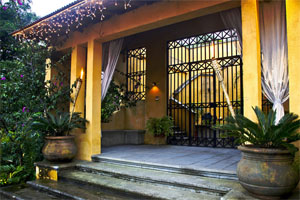 |
|---|
Main Entrance to Victoria's Restaurant |
The dining room is a high-ceilinged, very woody area, with walls lined in wood, columns covered in wood panels and lacquered wood dining tables. The wide use of indirect lighting gives the room a rich and comfortable feeling. For me it was reminiscent of the dining rooms one used to see at men's clubs like the Union League Club of Chicago..
The tables, as mentioned, are hardwood typical of the area and so are the chairs except the latter are padded, a fact this old back appreciates. The tables are set plainly with no flowers or decorations and only a small candle floating in water.
The menu has a good number of pasta and pizza dishes as promised and two daily specials were also offered, a lobster thermidor and a penne pasta with chunks of lobster and spicy sausage in a creamy pesto sauce. Yours truly chose the penne pasta and my dining partner chose a pasta dish with shrimp. We passed on the appetizers as we had just come from having Tapas at Sunset at the Hotel Gaia. We also passed on the deserts which were limited in number but looked enticing. Both entrees were reported tasty and fresh by the ROMEOS.
The service was prompt and friendly from our Italian server who was from Venice. The only concern raised was that out pasta, when it reached the table, was a bit cool and only warn in the center of the pile. Personally I'd rather eat it that way than send it back for reheating. Victoria's is owned by a cheerful dude named Mark, a gregarious North Carolinian. When I mentioned the cool pasta to Mark, after it had been eaten, he immediately offered an order of bananas flambé gratis to make up for it, a proper and nice gesture that helped assuage the cool pasta experience. Our Italian waiter had a little difficulty juggling the two gravy boats of flammable material, almost setting the table on fire, but eventually burned out most of the alcohol. (GG only sampled the resulting banana product avoiding the possibility of residual liquor, something he does not permit himself). |
 |
|---|---|
$$$$$ |
For atmosphere, food quality and service we give Victoria's four sloths.
The bill for the pasta with lobster and spicy sausage and one coke came to 23,700 colones (about $47) with taxes and mandatory gratuity included. The other pasta dish with shrimp came to just under 19,000 colones or about $38. This puts the pricing in the top 10% of local restaurants and as a result we have to give Victoria's a 5$ rating for cost.
So, if price is not your primary concern and you want a somewhat different and pleasant dining experience, try Victoria's.
Founder's Quotes
"There are two ways to conquer and enslave a nation. One is by the sword. The other is by debt." - John Adams 1826
don Beto de Quepos, El Gringo Dorado Pura Vida! |
Be pithy but kind. I'm sensitive. |
|---|

